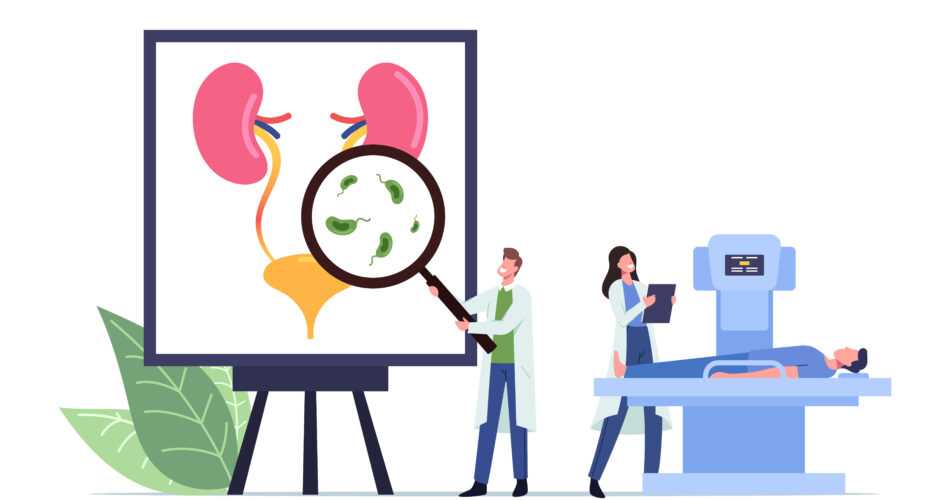Among the different types of UTIs, the acute UTI stands out due to its rapid onset symptoms and the necessity for swift treatment approaches. Its urgency for treatment makes it a serious situation to deal with. That’s why understanding the condition fully is a must for patients.
In this article, we will delve into the different aspects of this urinary condition. This guide will dwell into the important symptoms, causes and vital diagnostic procedures involved, Let’s begin!
What is Acute UTI?
Acute urinary tract infection, commonly referred to as acute UTI, is a bacterial infection that primarily affect the urinary system. The urinary system includes the kidneys, bladder, ureters, and urethra. When bacteria enter the urinary tract and multiply, this condition can occur. If left untreated, the infection can spread to the upper urinary tract, reaching the kidneys and causing more severe complications.
This condition can be a source of discomfort and pain for patients. It can significantly impact a person’s quality of life and may require medical intervention. Thus, the importance of immediate intervention by visiting a specialty doctor for scheduled early diagnosis.
Causes and Risk Factors

Acute UTIs are commonly caused by bacteria, with the most common culprit being escherichia coli (E. coli) bacteria. These bacteria can enter the urinary tract through the urethra, most often due to poor hygiene practices or sexual activity.
While anyone can develop an acute UTI, certain risk factors can increase the chances of infection. These factors may involve both the patient’s habit and hygiene practices. Furthermore, it can also involve the natural aspects such as the patient’s anatomy, making them more prone to this condition. Let’s discuss each below!
Anatomy
The first factor that can result patients to contracting the disease is the patient’s anatomy, specifically the female. For instance, women are more prone to UTI due to the shorter urethra, which allows bacteria to reach the bladder more easily. This situation can trigger urinary tract abnormalities, such as kidney stones or urinary tract obstructions.
Hygiene
On the other hand, another factor that can affect the urinary system of a patient is their hygiene practices. It is important to keep the genitals dry to avoid bacterial growth.
Sexual Activity
It is important to note that while sexual activity can contribute to the development of acute UTIs, they are not considered sexually transmitted infections. However, certain sexual behaviors, such as frequent or vigorous intercourse, can increase the risk of bacterial entry into the urinary tract.
Other Illnesses
Moreover, there are also other factors that can result in this illness. This can involve health complications such as diabetes and HIV. Patients with diabetes are prone to kidney failure due to less insulin that balances the blood level. With such condition, it can affect the concentration of the urine, which makes them easier to contract uti.
The same with HIV patients, they have the bacterial progressions that can lead to UTI. That’s why it’s best for patients with both conditions to maintain a healthy lifestyle. Thus, helping them to lessen the odds of having acute uti.
Recognizing the Symptoms of Acute UTI
Recognizing the symptoms of an acute urinary tract infection is crucial in order to seek prompt medical attention and start the appropriate treatment. The symptoms can vary from person to person, but some common signs to look out for include:

Common Symptoms
- Strong and persistent urge to urinate: One of the most common symptoms of an acute UTI is a strong and persistent urge to urinate. This urge may be accompanied by a feeling of pressure or discomfort in the bladder.
- Frequent urination, often in small amounts: People with UTI often experience frequent urination, even if they have only a small amount of urine to pass. This symptom can be bothersome and disruptive to daily activities.
- Burning sensation during urination: Another telltale sign of an acute UTI is a burning sensation or pain during urination. This discomfort is caused by the inflammation and irritation of the urinary tract.
- Cloudy or dark-colored urine: UTI can cause changes in the appearance of urine. It may appear cloudy or have a dark color, indicating the presence of bacteria, blood, or pus in the urinary tract.
- Blood in the urine: Hematuria, or blood in the urine, is a concerning symptom that can occur with UTI. The presence of blood may give the urine a pink, red, or brownish color.
- Strong-smelling urine: Patients often notice that their urine has a strong, unpleasant odor. This odor is caused by the presence of bacteria and other infectious agents in the urinary tract.
- Pelvic pain in women: Women may experience pelvic pain or discomfort with an acute UTI. This pain can range from mild to severe and may be accompanied by a feeling of pressure or heaviness in the pelvic area.
If you experience any of these symptoms, it is important to seek medical attention promptly, as untreated acute UTIs can lead to more severe complications, such as kidney infections. Kidney infections can cause serious health problems and may require hospitalization and intravenous antibiotics to treat.
Patients can try online consultations with an accredited health professional for immediate intervention. It’s best to visit the hospital near you to begin.
When to Seek Medical Attention
If you suspect you have an acute UTI, it is recommended to consult with a urinary health expert. They can perform the necessary tests to diagnose the infection and determine the most suitable treatment plan.
In addition to a physical examination, your healthcare provider may request a urine sample for urinalysis and culture. These tests can help identify the specific bacteria causing the infection and determine the most effective antibiotic treatment. Prompt diagnosis and treatment of UTIs can help alleviate symptoms, prevent complications, and promote a speedy recovery.
Diagnostic Procedures for Acute UTI

In order to confirm the presence of an acute UTI and identify the specific bacteria causing the infection, several diagnostic procedures may be conducted. These procedures include:
Urinalysis and Urine Culture
A urinalysis involves analyzing a urine sample to detect any abnormalities, such as the presence of bacteria or white blood cells. This test is essential in diagnosing a UTI as it helps determine if an infection is present. During a urinalysis, a healthcare professional will examine the color, clarity, and odor of the urine. They will also check for the presence of red and white blood cells, as well as bacteria. By identifying these markers, the healthcare professional can confirm the presence of an acute UTI.
In addition to a urinalysis, a urine culture is also performed to identify the specific bacteria responsible for the infection. This involves taking a portion of the urine sample and placing it in a culture medium that promotes bacterial growth. The culture is then observed over a period of time to determine the type of bacteria present. This information is crucial in selecting the most effective antibiotics for treatment. By identifying the specific bacteria causing the infection, healthcare professionals can tailor the treatment plan to target the specific strain.
Imaging and Other Diagnostic Tests
In certain cases, healthcare professionals may recommend additional diagnostic tests to assess the condition of the urinary tract and identify any structural abnormalities that may contribute to the development of acute UTIs. One such test is an ultrasound, which uses sound waves to create images of the urinary tract. This non-invasive procedure can help identify any abnormalities, such as kidney stones or an enlarged prostate, which may increase the risk of UTIs.
Another diagnostic test that may be performed is a CT scan. This imaging technique provides detailed cross-sectional images of the urinary tract, allowing healthcare professionals to visualize the structures in greater detail. A CT scan can help identify any structural abnormalities, such as tumors or strictures, that may be contributing to the development of acute UTIs.
In some cases, a cystoscopy may also be recommended. This procedure involves inserting a thin, flexible tube with a camera into the urethra and bladder to visualize the urinary tract. A cystoscopy can help identify any abnormalities, such as bladder stones or urethral strictures, that may be causing recurrent UTIs.
Treatment Approaches for Acute UTI
Once diagnosed with an acute UTI, swift treatment approaches are necessary to alleviate symptoms, eradicate the infection, and prevent potential complications. The treatment for acute UTIs typically involves:
Antibiotics and Other Medications
The most common treatment for acute UTIs is a course of antibiotics. The specific antibiotic prescribed will depend on factors such as the type of bacteria causing the infection and the individual’s medical history. Antibiotics work by killing the bacteria or preventing them from multiplying, allowing the body’s immune system to clear the infection. It is important to complete the full course of antibiotics as prescribed by the healthcare professional to ensure that the infection is fully eradicated.
In addition to antibiotics, healthcare professionals may recommend medications to alleviate symptoms. Pain relievers, such as nonsteroidal anti-inflammatory drugs (NSAIDs), can help reduce discomfort during urination. These medications work by reducing inflammation and blocking pain signals, providing relief while the body fights off the infection.
Home Remedies and Lifestyle Changes
While antibiotics are essential for treating acute UTIs, certain home remedies and lifestyle changes can complement the medical treatment. These measures aim to support the body’s natural healing process and prevent future infections. Here are some home remedies and lifestyle changes that may be recommended:
- Staying hydrated: Drinking plenty of water helps flush out bacteria from the urinary tract and dilutes the urine, making it less irritating.
- Urinating frequently: Emptying the bladder regularly helps eliminate bacteria and prevents them from multiplying.
- Avoiding irritants: Certain substances can irritate the urinary tract and worsen UTI symptoms. It is advisable to avoid or limit the consumption of caffeine, alcohol, spicy foods, and acidic beverages.
- Maintaining good hygiene practices: Proper hygiene is crucial in preventing UTIs. Women should always wipe from front to back after using the toilet to avoid spreading bacteria from the anal area to the urethra. It is also important to wear breathable cotton underwear and avoid tight-fitting clothing, as these can create a moist environment that promotes bacterial growth.
- Applying heat: Placing a warm compress on the lower abdomen can help relieve pain and discomfort associated with UTIs.
It is important to note that while home remedies and lifestyle changes can provide some relief and support, they should not replace medical treatment. It is always recommended to consult with a healthcare professional for proper diagnosis and treatment of UTIs.
Preventing Acute UTI Recurrence
For individuals who have experienced an acute UTI, preventing recurrence becomes vital. By implementing certain preventive measures, the risk of developing future infections can be significantly reduced.
Hygiene Practices
Practicing good hygiene is crucial in preventing recurrent acute UTIs. This includes regularly washing the genital area with mild soap and water, urinating before and after sexual activity, and avoiding the use of harsh or perfumed hygiene products.
Dietary Considerations
Maintaining a healthy diet and lifestyle can also contribute to preventing acute UTI recurrence. Consuming foods rich in antioxidants and vitamins, such as fruits and vegetables, along with staying hydrated, supports a healthy immune system and urinary tract function.
HMO Plans
Aside from keeping the body healthy, it is also best to be prepared when it comes to dealing with this condition. There are several ways to handle the situation, and an effective way to be financially available to receive the necessary treatment plan. Having a high coverage HMO is the way to go. Consult with some of the notable HMO providers and utilize their services upon dealing with the recurrence of the condition.
Conclusion
Seeking prompt medical attention, and following the appropriate treatment approaches are key in effectively managing acute UTI. By being vigilant and proactive, individuals can take control of their urinary health and maintain overall well-being. That includes analyzing and monitoring their health to avoid their chances of having the disease.
However, as discussed earlier, there are certain factors that can influence the patient’s health. By understanding these risks and working with a urologist, it can be handled well. So, book an online consultation with health expert today to begin a healthier journey against UTI.
Test Your Knowledge: Acute UTI
How well do you understand urinary tract infections? Take this 5-question quiz!



